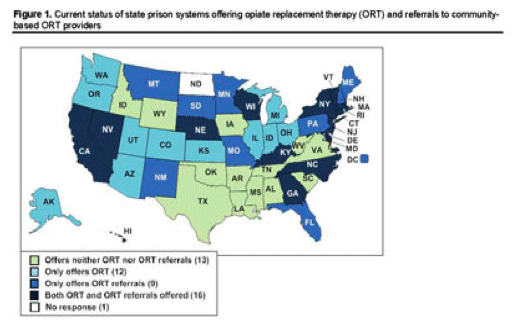| |
Addiction, HCV & Prisons
|
| |
| |
from Jules: This report is particularly of interest as it relates to HCV as we enter into a new era o treatment with 20 oral antivirals in development. Patients in & out o prison will begin to want to be tested and treated for HCV once we have 75% SVR rates. Within several years therapy will consist of a regimen of 3 or 4 oral drugs with or without peg/RBV and then SVR rates will be 80% to 100%. Then prisons will treat more people and the investment in care and treatment for HCV may be able to be turned into a greater interest to treat their addictions after spending lots of resources on the HCV disease. Once we have 85% SVR rates all HCV+ individuals will want to be tested and treated including current IV drug users, people on methadone and people on the fringes of society.
Study Finds U.S. Prison System Falls Short in Treating Drug Addiction
Almost a quarter of a million individuals addicted to heroin are incarcerated in the United States each year. However, many prison systems across the country still do not offer medical treatment for heroin and opiate addiction, despite the demonstrated social, medical and economic benefits of opiate replacement therapy (ORT).
According to new research from The Miriam Hospital, Brown University and their affiliatedCenter for Prisoner Health and Human Rights, just half of all federal and state prison systems offer ORT with the medications methadone and buprenorphine, and only in very limited circumstances. Similarly, only twenty-three states provide referrals for some inmates to treatment upon release from prison. These policies are counter to guidelines issued by both the World Health Organization (WHO) and the Centers for Disease Control and Prevention, which say prisoners should be offered ORT for treatment of opiate dependence.
The study's findings are published online by Drug and Alcohol Dependence.
"Pharmacological treatment of opiate dependence is a proven intervention, is cost-effective and reduces drug-related disease and reincarceration rates, yet it remains underutilized in U.S. prison systems," said Amy Nunn, ScD, the study?s lead author and an assistant professor of medicine (research) at The Warren Alpert Medical School of Brown University. "Improving correctional policies for addiction treatment could dramatically improve prisoner and community health as well as reduce both taxpayer burden and reincarceration rates."
"Opiate addiction, like all forms of addiction, causes long-term changes to the structure and functioning of the brain, which is why it is classified as a disease. Addiction requires treatment just as other chronic diseases, like diabetes and cancer, do. Unfortunately, there is a large gap between the number of prisoners who require addiction treatment and those who actually receive it," added senior author Josiah Rich, MD, MPH, co-director of the Center for Prisoner Health and Human Rights at The Miriam Hospital and Alpert Medical School.

The U.S. has the world?s highest incarceration rate, with approximately 10 million individuals incarcerated each year. More than half of inmates have a history of substance use and more than 200,000 people with heroin addiction are incarcerated annually. Inmates face disproportionately higher burdens of mental illness, substance use and infectious diseases, including HIV/AIDS. Meanwhile, their transition back to their communities is often associated with increased sexual health and drug-related risks, and more than half will relapse within one month of their release.
For the past four decades, methadone has been the treatment of choice for opiate dependence. It prevents withdrawal symptoms and drug cravings, blocks the euphoric effects of other opiates, and reduces the risk of relapse, infectious disease transmission and overdose death. The drug buprenorphine is a newer treatment for opiate replacement that has less likelihood of overdose and is associate
|
|
| |
| |
|
|
|